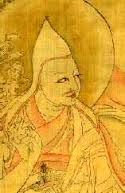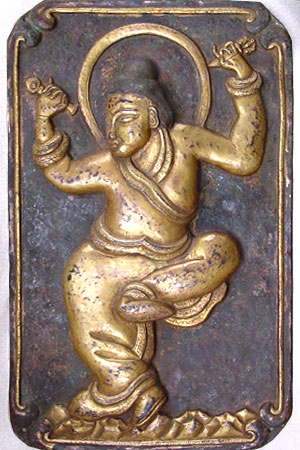Peter Kingsley’s book A Story Waiting to Pierce You: Mongolia, Tibet and the Destiny of the Western World (2010) argues forcefully that shamanism is the heart of philosophy and that the concept of incarnation and re-incarnation is central as well. The word tulku in Mongolian and Tibetan tradition was used “for identifying a great being who out of compassion has decided to become embodied by taking birth in human form (p. 41).” Kingsley claims that the Mongolian shaman Abaris traveled to ancient Greece and recognized Pythagoras as an incarnation of the god Apollo. He did this by giving Pythagoras the golden arrow which he carried in his hand.  The symbols of the Greek god Apollo were his bow and golden arrows. Kingsley argues, based on the extant texts, that the philosopher Parmenides was also a tulku, an incarnation of Apollo.
The symbols of the Greek god Apollo were his bow and golden arrows. Kingsley argues, based on the extant texts, that the philosopher Parmenides was also a tulku, an incarnation of Apollo.
Those of us who are familiar with the concept of the tulku will find Kingsley’s scholarly approach somewhat shocking, since he doesn’t pull any punches. He takes us back to June 19th, 1578, when the Mongol ruler Altan Khan met with the Tibetan Buddhist monk, Sonam Gyatso. Each recognized the other as a tulku. Altan Khan was recognized “as the reincarnation of Kublai Khan, belonging in an unbroken line extending back to Genghis Khan himself (p. 59).” Sonam Gyatso was recognized by Altan Khan as a tulku and “became the first Tibetan to receive the Mongolian title “Dalai Lama.” (p. 59)” These men exchanged special favors, but the one requested by the first Dalai Lama was something the twenty-first century people who know the work of the 14th incarnation of this same soul would find hard to believe. This is what Kingsley says.
The new Dalai Lama asked one particular favor of the Khan. This was that he wipe out every single trace of shamanism among his Mongol people, smash and burn their sacred instruments, exterminate their practices, silence their songs, and annihilate any shaman stupid enough to resist.
Soon, with the assistance of Mongol troops sometimes lining the streets to keep order in Lhasa, the Dalai Lamas had become rulers over the whole country. . . And over the centuries, across Mongolia as well as Tibet, orders for extending the persecution and extermination of shamans were not just issued with the new rulers’ silent approval.
And now in these very different times the sincerest messages of kindness and nonviolence, of spiritual oneness and global peace, are almost enough to let it all fall away: to erase any remaining memories of those forced conversions, mass murders, communities and traditions destroyed, of people’s land being seized from them together with anything else they could name until they no longer remembered who or what they were, and of the silenced songs that if they ever happen to be heard still have the power to take your heart away. (pp. 59 & 60)
The second incarnation of the Dalai Lama was found in Mongolia. He had bloodlines to the Tibetan kings. The persecution of other lineages of Buddhists continued throughout all the Dalai Lamas, including the reign of the famous Fifth Dalai Lama, “under whom the Gelukpa lineage of Tibetan Buddhists became the dominant power in the country–was an especially harsh and brutal period (p. 134).”  After the traditional Tibetan Bon practitioners had been the victims of mass murders at the hands of Tibetan Buddhist monks for many centuries, the Fifth Dalai Lama crushed their traditions, seized their lands, and forced them to convert. Then the pragmatic Great Fifth made peace. He “did acknowledge Bon as an independent tradition and reassure the surviving practitioners that they had a right to exist, just as he ended up doing with the other Buddhist traditions he had not completely destroyed (p. 134)”.
After the traditional Tibetan Bon practitioners had been the victims of mass murders at the hands of Tibetan Buddhist monks for many centuries, the Fifth Dalai Lama crushed their traditions, seized their lands, and forced them to convert. Then the pragmatic Great Fifth made peace. He “did acknowledge Bon as an independent tradition and reassure the surviving practitioners that they had a right to exist, just as he ended up doing with the other Buddhist traditions he had not completely destroyed (p. 134)”.
One might wonder why Kingsley brings the martial arts and political leadership into the picture of the Mongol and Tibetan religious tradition. If tulkus can be political leaders like Kublai Khan and the Dalai Lamas, then they could also be people like Zeno, Parmenides’ heir and adopted son, who saved Plato’s life. In fact that is precisely what Kingsley is saying, that anyone who was an incarnation of Apollo would have to have the god’s attributes. He was a warrior, destroyer, healer, law giver, and ruler. His healing ways had to do with what we would have to call shamanic traditions. Kingsley deals with that issue in his book (1999) In The Dark Places of Wisdom, which in itself is a fascinating read. I recommend both books. They are compelling and thought provoking.


Pingback: China, Tibet, and Karma « Ancient Whiteagle Wisdom
Reblogged this on Spiritual Transformations and commented:
The Tibetan belief in reincarnation poses problems of responsibility, if one soul continues to play the same role over 500 years. Combined with the idea of karma one wonders how today’s events are connected to the unique soul we call the Dalai Lama. Peter Kingsley raises the question Is the Dalai Lama paying for his horrible crimes as the Dalai Lama in previous incarnations?
The reality of karma is far too complex for simple correspondences, at least with respect to culpability. While there may be some after-effects of actions and intentionality from previous lives, due to imprints on one’s mental continuum (as the Dalai Lama has said), the “consciousness package” that transmigrates is on a learning curve, generating a tremendous amount of experiences over time, which always result in a mix of karma both negative and positive (usually called “merit”). I don’t think that Tibetan Buddhism holds that the soul plays the “same role” over time (I think the notion of maintaining an archetypal role over many lifetimes can be found more in a channeled system called the Michael Teachings); rather, it’s that responsibility is commensurate with the degree of awareness the practitioner is able to develop and maintain going forward.
As to Peter Kingsley, I read and enjoyed “In the Dark Places of Wisdom” but did not enjoy my second encounter with him (“A Story Waiting to Pierce You”) very much; it seemed the person who wrote that book was full of irritation and had axes to grind… The first book was full of provocations, to be sure, but it was well thought out and presented in a measured way that possessed a high degree of conviction… an exhilarating, inspiring book. But while there’s no doubt that Tibetan history is a troubled and tragic one, on many levels, Kingley’s point-making in “Story” about lost Western spiritual tradition seemed to be deliberately at the expense of Tibet… at least in this recent book.